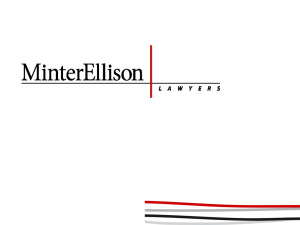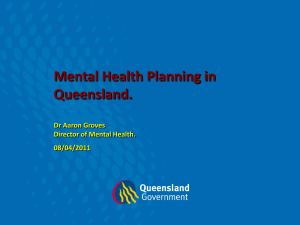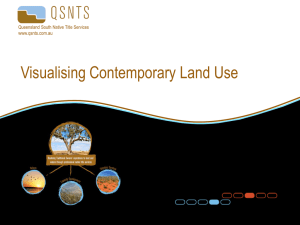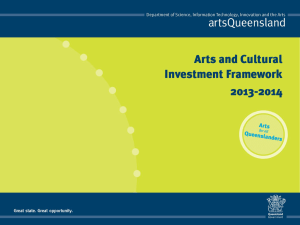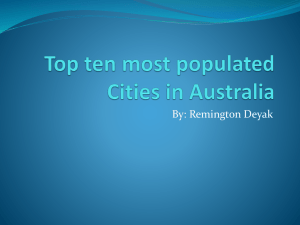Commission of Audit - University of Queensland
advertisement
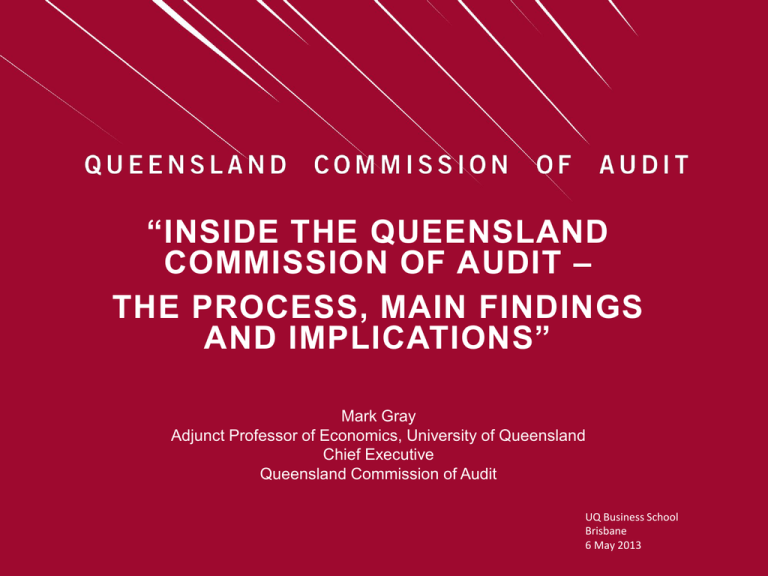
“INSIDE THE QUEENSLAND COMMISSION OF AUDIT – THE PROCESS, MAIN FINDINGS AND IMPLICATIONS” Mark Gray Adjunct Professor of Economics, University of Queensland Chief Executive Queensland Commission of Audit UQ Business School Brisbane 6 May 2013 THE PROCESS 2 ESTABLISHMENT • Pre-election commitment of the incoming Government • Commission announced 29 March 2012, and Terms of Reference issued Commissioners Honourable Peter Costello, AC Professor Sandra Harding Dr Doug McTaggart 3 TERMS OF REFERENCE – OBJECTIVES • Comprehensive – two pages of text • Review Queensland Government’s current and forecast financial position, and make recommendations on: – strengthening Queensland economy – Improving State’s financial position, including regaining AAA credit rating – ensuring value for money in delivery of front-line services 4 TERMS OF REFERENCE – SCOPE • • • • • Key issues Financial position Improving the State’s financial position Service delivery Government commercial enterprises The economy • Terms of reference interpreted broadly by Commission – any matters relating to functions/activities of the Queensland Government 5 TERMS OF REFERENCE – TIMETABLE 15 June 2012 Interim Report covering state of the Government’s financial position 30 November 2012 Interim Recommendations 28 February 2013 Final Report delivered to Government 1 March 2013 Executive Summary of Final Report released 30 April 2013 Full Report and Government Response released 6 OTHER COMMISSIONS OF AUDIT Victorian Commission of Audit 1993 National Commission of Audit, Commonwealth Government 1996 Queensland Commission of Audit 1996 New South Wales Commission of Audit 2012 Victorian Commission of Audit 2012 7 WHAT IS A COMMISSION OF AUDIT? • Comprehensive review of the role, functions, activities of government – Focus on efficiency, effectiveness and value for money • Not an “audit” in the formal sense – not a “financial audit” – not a “performance audit” – but contains elements of both • Unique perspective – view from “the outside looking in”, not an inside view • Opportunity only arises infrequently – often with a change of government – Rarely instigated by incumbent governments 8 KEY FEATURES • Independence • Transparency • Not bound by government policy • Opportunity – to challenge the status quo – to consider innovative solutions (e.g. for service delivery) – to propose strategic objectives/direction for government – to set agenda for change over period of 10-20 years 9 PROCESS • Secretariat established to support the Commission – small group: primarily public service officials seconded from Queensland Government agencies – some limited use of external consultants – Secretariat organised into teams to review key topics – worked under the direction of the Commission • Extensive powers of investigation available to the Commission • Funding provided from internal savings in Queensland Treasury and Trade 10 PROCESS cont…. • Submissions from all core Government departments and Government Owned corporations (GOCs). • No public submissions – some unsolicited submissions received and considered • No public hearings – Commission met with Chairs and CEOs of all GOCs • Secretariat had extensive ongoing contact with departments and limited contact with external parties • Secretariat undertook research and analysis of issues, prepared papers for Commission’s deliberations – papers formed basis for Reports 11 MAIN FINDINGS AND IMPLICATIONS 12 OVERVIEW OF FINAL REPORT • Focus of the Report is renewal in the public sector to provide better front-line services • Most comprehensive review of Queensland Government functions ever undertaken • 155 recommendations across four major headings (Front-Line Service Delivery, Public Sector, Financial Management, and Government Commercial Enterprises) • 39 separate sections • 1,000 pages of analysis • 247 charts • 127 tables • 36 diagrams • 47 case studies / illustrations 13 GOVERNMENT RESPONSE 118 accepted (76%) 7 accepted in principle 6 accepted in part 13 noted 5 for further consideration 6 not accepted ) ) ) ) ) 96% 14 ECONOMIC AND FISCAL CHALLENGE The challenge for Queensland is to lift its productivity performance to sustain the economic growth which will improve living standards for its citizens. 15 ECONOMIC AND FISCAL CHALLENGE cont … Multifactor productivity growth, trend (a), 1985-86 to 2011-12 3 Queensland Rest of Australia 2 % 1 0 -1 -2 1986-87 1991-92 1996-97 2001-02 2006-07 2011-12 (a) Trend estimates are derived from original MFP data using an 11-term Henderson-weighted moving average. Source: Queensland Treasury and Trade 16 ECONOMIC AND FISCAL CHALLENGE cont … ‘Business as usual’ – Projected fiscal deficit Fiscal deficit as a share of GSP 4 Lower growth Higher growth 0 % of GSP -4 -8 -12 -16 -20 2015-16 2050-51 17 ECONOMIC AND FISCAL CHALLENGE cont … • Pressure on fiscal position – Lower economic growth expected in future – Ageing of the population – Increased demand for government services • Changes in service delivery to maintain stable fiscal position – Productivity improvements of 1% year after year – Costs to be reduced by one-third over 40 years • This would lift GSP growth by 0.5% pa (extra $8,320 per capita pa in today’s dollars by 2050-51) 18 SIZE OF GOVERNMENT State Government expenditure as share of GSP NSW Vic Qld WA SA 18 17 16 15 % of GSP 14 13 12 11 10 9 8 1983-84 1987-88 1991-92 1995-96 1999-00 2003-04 2007-08 2011-12 19 ROLE OF GOVERNMENT Private provision of public services 20 ROLE OF GOVERNMENT cont … Key principles to manage and deliver services • • • • • • • • Focus on core services Facilitate contestability in service delivery Better demand management Greater workforce flexibility Capacity building Lower overhead costs Strengthen financial management Build productive capacity 21 FRONT-LINE SERVICE DELIVERY The Government must achieve better value for money in service delivery. ‘Business as usual’ is not a sustainable option. The primary responsibility of the Government is to ensure services are delivered, not necessarily to be the agency that actually does the delivery. It needs to be the ‘enabler’, not necessarily the ‘doer’. 22 FRONT-LINE SERVICE DELIVERY cont … State public sector wages: Queensland relative to all-states average 110 % 105 100 95 90 1983-84 1987-88 1991-92 1995-96 1999-00 2003-04 2007-08 2011-12 23 FRONT-LINE SERVICE DELIVERY cont … Cost of service provision by state, 2010-11 108 Qld % of national average 106 104 SA 102 WA 100 Vic 98 96 NSW 94 24 FRONT-LINE SERVICE DELIVERY cont … Queensland public hospital expenditure and activity trends Recurrent expenses Weighted activity units 150 Index: 2007-08 = 100 140 130 120 110 100 90 2007-08 2008-09 2009-10 2010-11 2011-12 25 FRONT-LINE SERVICE DELIVERY cont … Cost per casemix-adjusted separation, 2010-11 Australian average $ per casemix-adjusted separation 5,400 5,200 5,000 4,800 4,600 4,400 4,200 4,000 NSW Vic Qld WA SA 26 FRONT-LINE SERVICE DELIVERY cont … • Find more innovative and efficient ways of delivering services – reduce the high costs of service delivery – drive higher productivity • Greater role for non-government providers in owning assets and delivering services (e.g. through contestability) 27 FRONT-LINE SERVICE DELIVERY cont … RECOMMENDATIONS Areas for greater involvement of non-government sector • clinical, clinical support and non-clinical services in public hospitals • mental health and community health services • residential aged care facilities • disabilities • child safety • corrective services • social inclusion • public housing services 28 FRONT-LINE SERVICE DELIVERY cont … RECOMMENDATIONS cont … Education • improved student performance through increased devolution, autonomy and accountability at individual school level. VET • independent industry-led skills authority • competitive market • asset ownership to be separated from TAFE Police and Emergency Services • more flexible risk-based resourcing • greater co-location of facilities to provide better integrated emergency responses and better asset utilisation 29 THE PUBLIC SECTOR The goal for the public sector must be to achieve the highest standard of excellence and ensure that Queensland is the best administered state in Australia. 30 PUBLIC SECTOR ARRANGEMENTS Employing legislation • PS Act • 15 other acts Awards • 50 Awards • 50-60 Certified Agreements Variability, anomalies and inconsistencies Increased costs and complexity in administration of payroll, HR and IR systems Classification framework • 250 levels • 750 pay points Unnecessary complexity and rigidity Health Payroll • 10 Awards • Multiple industrial agreements • 200 different allowances • 24,000 different pay combinations 31 THE PUBLIC SECTOR cont … RECOMMENDATIONS • Rationalise and consolidate core public service employment conditions • Consolidate and simplify awards and certified agreements • New flexible broad-banded classification system for public service • Appointment of employees to broad-banded levels (not agency specific positions) • More effective performance management system 32 THE PUBLIC SECTOR cont … RECOMMENDATIONS cont … • ‘ICT as a service’ strategy – Source software, hardware and infrastructure as a service from private providers – Government should not own and manage ICT assets • CITEC role to be discontinued within 2 years • Reduce overhead administrative and corporate costs e.g. contestability of corporate services • Queensland Shared Services (QSS) operate on contestable basis (not mandated) 33 FINANCIAL MANAGEMENT There is an urgent need to restore the highest standards of financial management to public administration – with an enhanced long term financial planning framework, improved budget, cash and asset management, and greater transparency and accountability. 34 FINANCIAL MANAGEMENT PRACTICES Relationship between the elements of the Appropriation Bill 2012 2010-11 financial year 2011-12 financial year 2012-13 financial year 2013-14 financial year Supplementary Appropriation for Unforeseen Expenditure (retrospective) Supplementary Appropriation for Unforeseen Expenditure1 (retrospective) Appropriation sought for budget (vote) (prospective appropriation) Supply (interim appropriation) 35 FINANCIAL MANAGEMENT cont … RECOMMENDATIONS • • • • • • Intergenerational Report State Infrastructure Plan Simplified appropriation framework Improved budget, cash and asset management Charter of Budget Accountability Greater role for private sector in infrastructure investment • Queensland Productivity Commission 36 FISCAL REPAIR STRATEGY • Commission’s recommended strategy (Interim Report) - arrest deterioration in State’s financial position and stabilise position - pay down debt • $25-30 billion debt reduction necessary to restore financial strength and provide buffer for adverse events - Will also restore AAA credit rating • Debt reduction of this magnitude can only be achieved by releasing capital from the State’s balance sheet 37 38 39 40 Total Government debt to revenue ratio 140% Actual Projection 120% Trigger range for AAA credit rating 100% 80% 60% 40% 20% 0% 2000-01 2003-04 2006-07 2009-10 2012-13 2015-16 Source: Treasury 41 Total Government gross debt, share of GSP 30% Projection Actual Queensland 25% New South Wales Victoria 20% Western Australia 15% 10% 5% 0% 2000-01 2002-03 2004-05 2006-07 2008-09 2010-11 2012-13 2014-15 Source: Australian Bureau of Statistics 5512.0, State Budgets and Mid Year updates, Treasury 42 Actual Source: Treasury 43 FISCAL REPAIR STRATEGY • Commission’s recommended strategy (Interim Report) - arrest deterioration in State’s financial position and stabilise position - pay down debt • $25-30 billion debt reduction necessary to restore financial strength and provide buffer for adverse events - Will also restore AAA credit rating • Debt reduction of this magnitude can only be achieved by releasing capital from the State’s balance sheet 44 GOVERNMENT COMMERCIAL ENTERPRISES The Government must make better use of its balance sheet, by releasing capital locked up in mature assets to pay down debt, lower interest costs and free up funds for investment in new infrastructure (for example, flood prevention). 45 GOVERNMENT COMMERCIAL ENTERPRISES Commercial assessment tests 1. No need for government to own assets that compete with private services in workably contestable markets 2. No need for government to own commercially sustainable businesses 3. Where government remains responsible for services: • deliver through own agency or non-government providers • deliver through contestability 46 GOVERNMENT COMMERCIAL ENTERPRISES cont …. Ownership patterns in the National Electricity Market – by indicative market share Australian Electricity Market Operator / Australian Energy Regulator Generation 2 Origin Energy (multi-region) TRUenergy (multi-region) AGL (multi-region) International Power Other Generators (Vic & SA) Transmission3 Electranet (SA) Distribution4 ETSA (SA) Retail 5 Transgrid (NSW) SP Ausnet (Vic) Powercor, SP AusNet, United, CitiPower, Jemena (Vic) Origin Energy (multi-region) Private Ownership Essential (NSW) AGL Energy (multi-region) Actew AGL Public- Private JV AETV Snowy & Hydro Hydro (Vic & NSW) Tas Delta & Mac Gen (NSW) Powerlink (Qld) Transend (Tas) AusGrid (NSW) Endeavour a (NSW) TRUenergy (multi-region) Public (planned to be privatised)6,7 CSE & Stanwell (Qld) Energex (Qld) Other Retailers Aurora (Tas) Ergon (Qld) Ergon (Qld) Public Ownership a Aurora Energy distribution 47 GOVERNMENT COMMERCIAL ENTERPRISES cont …. Key events for energy sector GOCs 1 July 2012 1 July 2013 1 July 2014 1 July 2016 1 July 2015 Fixed price carbon tax 1 July 2017 1 July 2018 Market carbon permit cost Increasing LNG demand Current Powerlink pricing period Current Ergon and Energex pricing period New Powerlink pricing period New Ergon and Energex pricing period Source: Commission of Audit 48 GOVERNMENT COMMERCIAL ENTERPRISES cont …. RECOMMENDATIONS • Dispose of businesses operating in commercial markets, when conditions favourable: – – – – – – – – Energex ($9.2B) Ergon ($7.7B) Powerlink ($5.3B) CS Energy ($0.9B) Stanwell ($1.7B) Gladstone Ports Corporation ($1.2B) Townsville Port Authority ($376M) Queensland Investment Corporation ($18M) 49 GOVERNMENT COMMERCIAL ENTERPRISES cont …. OTHER GOC RECOMMENDATIONS Transport Services • Bulk Ports North Queensland to have supply chain coordination role. • Mount Isa rail freight line integrated with Townsville Port Authority • Passenger rail and bus services to be restructured to be delivered through: – contestable contracts – franchise and lease arrangements Reform of GOC governance model • Single shareholding Minister model • Improve efficiency of GOCs – Reform restrictive workplace practices – Remove unnecessary policy restrictions – Make transparent full cost of Government policy requirements 50 “BUSINESS AS USUAL” IS NOT SUSTAINABLE • High cost of delivering services • Low productivity • Ageing population and workforce placing pressure on financial position Expenses expected to rise faster than revenues 51 STRATEGIC BLUEPRINT Innovative service delivery (including greater use of non-government sector) Improved public sector flexibility and efficiency Unlock scarce capital and free up resources for debt reduction and new investment Greater productivity and better resource use including use of capital More front-line services (with stable fiscal position) 52 VALUE OF COMMISSION OF AUDIT PROCESS • • • • • • • Independent, objective, arm’s length view No “baggage” Fresh look at the way things are done Valuable input from the bureaucracy Long term strategic perspective Opportunity for renewal and reform Decisions are a matter for government 53

